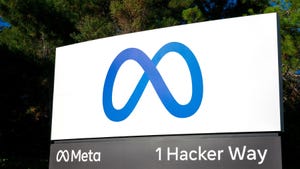Facebook Installs Solar Panels at New Data CenterFacebook Installs Solar Panels at New Data Center
Facebook has installed a large array of solar panels at its new data center in Prineville, Oregon, placing it among a handful of data centers that use on-site solar power generation at its facilities.
April 16, 2011

facebook-solarpanels
Facebook has built a large solar array next to its new data center in Prineville, Oregon (Photo: Rich Miller, Data Center Knowledge).
Facebook has installed a large array of solar panels at its new data center in Prineville, Oregon, which will supplement the local utility in providing electricity for the 300,000 square foot facility, which was officially opened at a ceremony yesterday.
For more than a year, the environmental group Greenpeace International has been bashing Facebook over its use of electricity generated by "dirty coal" to support its huge new Oregon data center - a campaign that continued Friday as Facebook opened the new facility.
Solar Array
The large solar array in Prineville makes Facebook one of only a handful of data centers in the world to install on-site solar power generation (see Solar-Powered Data Centers for more examples).But it also illustrates the complexity of data center power sourcing, and the difficulty in reducing the issue to a "coal or no coal" litmus test. For most facilities, the Prineville solar array would represent a major commitment to renewable energy. The array can generate about 100 kilowatts of energy, with total expected production of 204,000 kilowatt hours a year.
The problem? In the data center world, 100 kilowatts isn't much power. Facebook hasn't said precisely how much power it is using in Prineville, but by the time the facility is complete it will be measured in dozens of megawatts of electricity. It typically takes about 7 acres of solar panels to generate 1 megawatt of power.
Will Support Office Space
The solar power generated by the Prineville solar array will be used primarily to support the office areas and some mechanical rooms that are less power-intensive, but not the server rooms. The system is mounted on a dual-axis tracker made by PV Trackers in Bend, Ore., which allows the panels to track the path of the sun throughout the day. The photovoltaic panels were manufactured by SolarWorld of Hillsboro, Ore., and installed by Sunlight Solar Energy of Bend.
"Facebook will closely monitor the functioning of the new system to see if similar systems can be installed at future data centers," the company said in a press summary.
Greenpeace International has critiqued Facebook’s decision to build its new data center in Prineville, where the local utility uses coal to generate the majority of its power. The environmental group has mounted petition drives and protests using its own Facebook page, letters to Facebook CEO Mark Zuckerberg and even animated cartoons demanding that Facebook rethink its data center site location decisions. The dispute generated widespread news coverage and prompted 600,000 Facebook users to call on the company to “unfriend dirty coal.”
On Friday, the group issued a press release titled "Facebook's First Data Center Has Bad Energy," noting the energy efficiency of the Prineville facility, but saying that it wasn't enough. "We have not yet seen Facebook take seriously the source of energy used to power its infrastructure," Greenpeace wrote. "Energy efficiency will reduce overall use, but in order to feed its growth sustainably, Facebook also needs to commit to the use of clean and renewable power."
'Increase Renewable Energy in Prineville'
The group's list of demands called on Facebook to "increase renewable energy in Prineville: Through some combination of direct on-site installation and investment in clean energy development (a la Google), Facebook should set a target to use more renewable energy to power its data center, and use its bulk purchasing power to work with Pacific Power on getting more renewable energy onto the grid."
Facebook has now increased its use of renewable energy in Prineville. Will the 100 kilowatts of solar power generation satisfy Greenpeace? The group routinely commends Google for its use of solar arrays, which also power office space rather than data centers.
Facebook VP of Technical Operations Jonathan Heiliger said the Prineville facility reflects its focus on using less energy. The new data center is operating at a Power Usage Effectiveness (PUE) of 1.07, placing it among the industry’s most efficient facilities. That efficiency will dramatically reduce the amount of power Facebook requires to run its data center and servers, said Heiliger, who said the company’s approach emphasizes the “negawatt.”
“That’s the watt you never see and never use,” said Heiliger. “We think that’s the most effective way for operators of large data centers to conserve energy.”
For more on this issue, see our Special Report:Data Centers & Renewable Energy.
About the Author
You May Also Like







